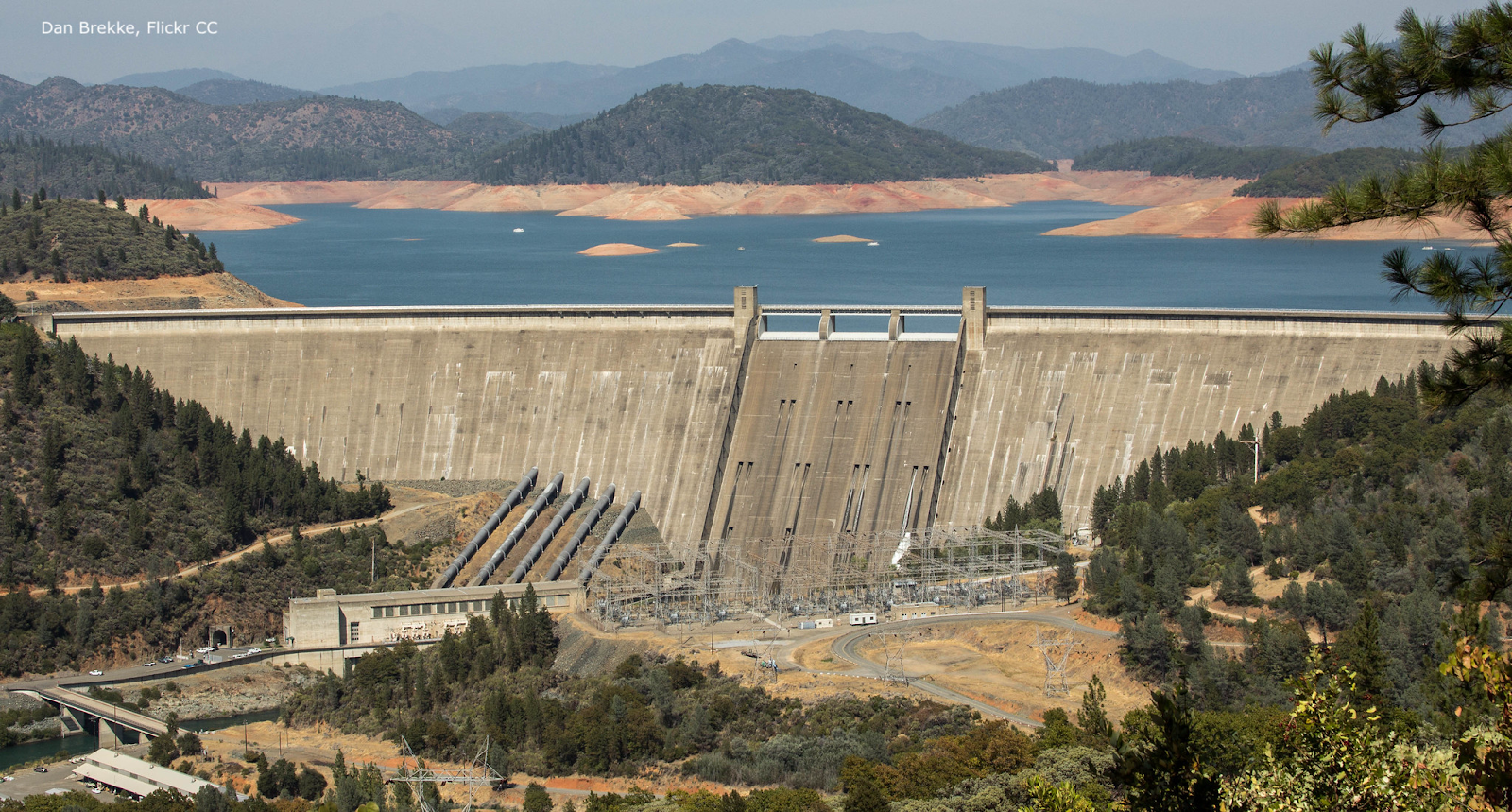Winter Rains and Snows Bring California Hydropower Back to Life
March 21, 2023
Heavy rain and snow has replenished California rivers and reservoirs, pointing to a good year for hydroelectric power generation. Hydro has a complicated role in California’s energy supply, economy, and ecology.

Shasta Dam in Northern California. (Photo by Dan Brekke, Flickr CC)
California’s worst drought in 1200 years has been disrupted by one of the wettest winters in decades. Repeated “atmospheric rivers” from the Pacific soaked northern California in December and January, and boosted the Sierra snowpack to its highest level in almost 30 years.
While it is too soon to say the drought is over, it is easier to predict the impact it will have on California’s power supply in 2023. With plentiful generation from hydroelectric dams, natural gas use will decline, driving down emissions and costs.
Water and power
Water and power are intimately related, not just for hydropower generation but also in water use for electric generation.
Thermal power plants, like coal, nuclear, and fossil gas, use vast amounts of water for steam production and plant cooling. In fact, thermal power generation is the largest non-consumptive use of water in the United States, while agriculture is the largest consumptive user. Power plants account for about 40 percent of all water withdrawn in the US.
The scarcity of big rivers and lakes in California has been an impediment to conventional thermal power plants. Instead, many plants have used ocean water for cooling. But this “once-through” approach creates big impacts on coastal marine life: some creatures are caught up in the intake pipes, while coastal habitats are affected by big surges of warm water that plants dump back into the ocean.
As a result, the State Water Resources Control Board, a state agency, has begun restricting the use of ocean water for cooling. Altogether 19 fossil gas plants with over 20,000 MW of capacity are in the process of shutting down, no later than 2029. (While most have shut down, the deadlines for some have been extended to allow more time to address local reliability concerns.)
Big Hydro
The other big impact from water is hydroelectric power. California gets, on average, about 15 percent of its electricity from dams. While many hydro projects are small “run of the river” projects in the Sierras, most of the power comes from big dams built and operated by the federal Bureau of Reclamation and the California Department of Water Resources. The dams also supply irrigation, drinking water, and recreation services, and need to be managed to protect wildlife.
Their output is, of course, deeply influenced by the availability of water. Over the last 20 years, output from California dams ranged from 48 million MWh in 2006 to only 14 million in 2015, which was less than 5 percent of state power needs that year. The drought in recent years crippled output from big dams across the West, including the Hoover and Glen Canyon dams.
Hydropower output in California has an inverse relationship with natural gas, as shown in the figure below. In dry years, hydro output falls, with the shortfall made up largely with natural gas power generation. Good hydro years, conversely, reduce demand for gas, saving a substantial amount of pollution and money.
Natural gas prices in California have hit historic highs this year, helping drive winter heating bills through the roof. A wet spring with lots of hydropower will displace gas used for power generation, and help drive down the cost of electricity this year.
Big tradeoffs from big hydro
EBCE got about 23 percent of its power portfolio in 2021 from hydropower. An additional unknown amount of hydropower came from “unspecified” sources, which is electricity traded through open market transactions, including dams from across the Western US.
Power from big hydro plants, over 30 MW, is not counted toward the state’s renewable portfolio standard (RPS). California gets about 1.5 percent of its power from smaller dams and “run of river” generators. EBCE got 42 percent of its power from RPS-eligible sources, mostly wind and solar, but only 0.2 percent from small hydro.
“Though big hydro doesn’t meet California’s RPS requirements, hydropower of any size meets the common definition of renewable, since its energy is replenished by natural sources,” says Marie Fontenot, VP of Power Resources.
“But big hydro really illustrates the tradeoffs that can come from energy,” she adds.
“It produces no emissions when it operates, but it can have really big impacts on rivers and local habitats, which is bad for fish and aquatic life.”
“And to complicate things, dams and reservoirs are probably most important as part of California’s water management system, providing flood control, drinking water, and irrigation. I’m not sure we could support 30 million people and be the number one food-producing state in America without them.”
This can certainly make them hard to get rid of. It took 15 years of debate, lobbying, and research to get final approval to remove four hydroelectric dams along the Klamath River on the Oregon/California border. The $500 million removal process will restore access to 400 miles of habitat for salmon and steelhead trout and revitalize tribal communities and cultures. It counts as the largest river restoration project in American history, and will be underway in 2023.
Keep your power dry
Much of EBCE’s electricity procurement has focused on sources that don’t depend on water flows, such as solar, wind, and geothermal power. These “drought tolerant” sources provide diversity that reduces the risk of a hydro-heavy supply in dry years, while not increasing carbon emissions.
Still, as EBCE moves toward a zero-emission power supply in 2030, hydroelectric power will likely remain a key part of the portfolio. Despite its vulnerability to drought, it provides important operating diversity and the ability to fill in gaps left by solar and wind power.